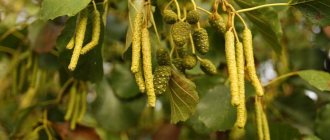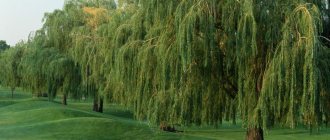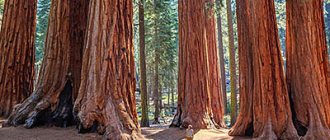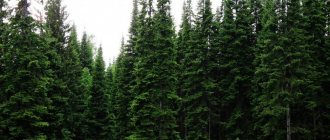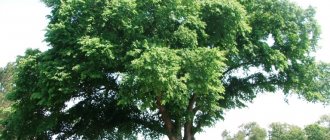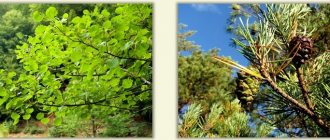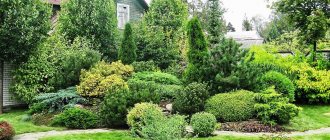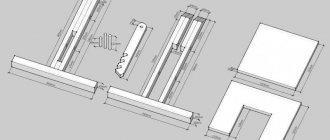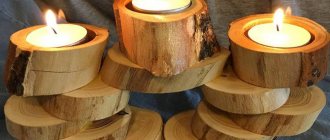Squat elm: description
The tree is distinguished by its tall growth and in nature, under favorable conditions, reaches 25 m with a trunk diameter of about 1 m. In the arid climate of its natural habitat, it transforms into a shrub. Despite the popular name elm, the bark of the tree is not black, but has a gray-brown or rich gray tint, is smooth, and cracks may form. Young shoots differ in color from adults. They have a light gray tint with yellowish tint, the surface is rough or smooth, with scattered lentils.
Squat elm has characteristic oval- or lance-elliptical-shaped leaves, reaching from 2 to 8 cm in length and 1.2-3.5 cm in width. The base of the plate is symmetrical with a pointed apex and jagged edges. The color of the leaf changes over the seasons, in the spring it is light green, in the summer it is more saturated, in the fall the tree acquires an olive-yellow hue (in the photo below the alley of elms in September-October). The fruit is an almost round lionfish, growing in diameter up to 1-1.5 cm, with a nut located in the middle.
First date with elm
Looking at photos of leaves and seeds of an elm tree, you can notice some unique features of their structure. With the help of this research, the gardener will not confuse it with other varieties. These slender giants have:
Smooth elm is the most popular elm variety. It is found in many city parks. This species tolerates harsh winters well and can withstand temperatures down to –28°C. But still, the shoots of the plant may freeze a little. Of the 16 popular varieties, half can be found on the Scandinavian Peninsula, as well as in Europe. If you analyze where the elm tree grows in Russia, you will notice that these are mainly humid regions, such as:
- Western Siberia;
- Volga region;
- Southern Urals (Chelyabinsk and Sverdlovsk regions);
- Kazakhstan;
- Caucasus.
Elm gets along well not only in a humid environment, but also in a dry climate, since it penetrates with its roots to underground sources. The banks of rivers and lakes, as well as deciduous forests, are their favorite habitats. Still, very compacted and saline soils negatively affect the life of the tree, although elm is unpretentious in the choice of soil.
Birch bark grows incredibly quickly. The annual growth of both a young seedling and an adult tree is 0.5 meters in height and 0.3 m in width.
Growing conditions
The squat elm, the photo of which you see in the article, does not have a high life expectancy - only 40-60 years. However, during this time it reaches impressive sizes. The growth rate of the tree is high and is not inferior to white acacia or ash maple. In cultivation, elm is unpretentious and makes minimal demands on soil fertility and moisture content. It even tolerates salinity, is highly resistant to drought, and is winter-hardy (withstands down to -36°C). The only thing that needs to be taken into account is that the tree is light-loving, tolerates partial shade, but develops worse.
Squat elm has been introduced into cultivation since 1860. Used for landscaping parks and squares. It is especially valued in the arid regions of the country. Forms a powerful superficial root system. It tolerates polluted city air, haircuts and pruning well. The latter features are used to create hedges. It reproduces only by seeds and does not form root suckers and, therefore, thickets, which is a definite plus. It has a decorative weeping shape with cascading branches. The tree is most beautiful during the fruiting period.
Main characteristics
Thanks to the flexible structure of wood fibers, many household items were woven from the resulting bast in ancient times. These were both exquisite sleighs and household utensils. The thinning of the arc and rim decorated the monastery of the inhabitants of ancient Rus'. At the same time, branches and leaves were widely used for tanning leather products.
The name of this tree comes from the Celtic language, which has a word such as "Elm". The German and Latin name of the plant are also very similar - “Ulmus”. The literal translation of all these words means “bending rod.”
Externally, the elm is a mighty tree, a description and photo of which are presented below. The trunk of this representative of elms at a young age is covered with smooth light brown bark. As the plant grows, it becomes thick and also quite rough and over time begins to peel off in thin sheets. Deep cracks on its surface resemble scars from battle wounds. Growths may form and develop on some branches.
The powerful root system of birch bark lies very deep, so it can easily reach the groundwater level. Thanks to this feature of the roots, the elm grows up to 25-30 m in height, with a trunk circumference of 1.5 m. However, some varieties do not take root deep into, but rather into the upper layers of the earth, occupying a huge area. Many members of this family can be between 200 and 300 years old.
The long-living record holder was able to survive the fire of 1812, which occurred in Moscow. However, it still could not survive the hot summer of 2010 and completely dried out.
Squat elm: how to use it in the garden?
Elm is a very beautiful tree with long shoots and large serrated leaves; it looks especially impressive in the fall, when it is completely covered with fruits. The plant has been used in ornamental gardening for a long time. When choosing it for planting on your site, you should remember that the tree is light-loving and only in the sun its beauty is fully revealed.
The crown lends itself well to pruning and shaping. However, there is no need to rush into this. In the first years of cultivation, only damaged and dry branches should be removed. Formative pruning is possible from about 4 years of growth, but do not forget about the use of garden varnish. In general, the tree is resistant to diseases and pests.
Squat elm, whose height reaches 25 m, is very good in group, single and mixed plantings, in the form of alleys in parks and as a tapeworm. Single planted specimens surrounded by smooth green lawns are very impressive, especially if you use a hybrid with a weeping crown shape. Only when nothing interferes with the tree can it reveal itself in its full glory. In such conditions, its crown will be of the correct shape, and its trunk will be straight and strong. Solitaire plantings are used as an accent on the site, as they always attract the eye. However, you should remember the proportionality of the plant and the area of the territory. For a large plot - a large tree and vice versa, otherwise all charm will be lost.
Features of breeding and care
Many people know about the medicinal properties of elm bark, leaves and fruits, so they want to have such luxury in their garden. Thanks to the diuretic and astringent effect of these natural components, it is used in the treatment of:
- gastrointestinal tract;
- skin diseases;
- swelling;
- rheumatism.
The extract obtained from the bark is used as an anti-inflammatory or antibacterial agent. Moreover, these trees create a cozy atmosphere in the garden. They “love” to be trimmed, so it’s easy to create a hedge from them.
It is important to adhere to the basic rules for planting elm seeds. As soon as they ripen, they should be immediately planted in the ground. The first two weeks are the optimal period for this. If you wait a little, they lose their properties. Although the seeds do not require preliminary preparation, they must be sowed correctly. To do this you need:
- dig up the bed thoroughly;
- add ;
- make the distance between rows from one to two meters;
- sow grains in increments of 30-50 cm;
- fill a small hole with a thin layer of soil;
- water generously.
You can also plant it in the shade. Nevertheless, on a lawn well warmed by the sun, it will grow several times faster. The elm crown expands very quickly, which can negatively affect neighboring light-loving plants. Among other things, since ancient times they have had mutual intolerance.
It is worth noting that June can surprise you with its hot weather. Therefore, the planted area must be covered with film until shoots appear. For about a month, young sprouts should be watered abundantly.
A perennial problem with the elm tree is Dutch disease. If there are many dried/unbloomed branches on it, peeling bark and at the same time the crown has a sparse appearance, it means that the birch bark is affected by this disease. The main reason for its occurrence is excessively moist soil. He can get sick in this way from several weeks to 5-7 years. Therefore, you need to monitor the level of soil moisture so that lush thickets always decorate the garden.
History of the elm tree - video
Squat elm is most widespread in commercial and garden plantings compared to other types of trees from the genus of the same name. Possessing absolute unpretentiousness, it has simultaneously become a valuable species in protective afforestation and a weed, along with which it choke out more valuable plantings.
Using elm for berso
One of the unusual uses of elm is to create beautiful berso. Covered galleries are created from crossbars installed on supports along garden paths or alleys. Trees are planted on the sides, the branches of which are carefully bent and secured to the frame. Gradually growing, they form a single continuous green tunnel, as in the photo. Considering the high speed of elm, the decorative effect can be achieved quite quickly.
In terms of design and appearance, the berso is often compared to a pergola. However, the latter can safely be called the younger sister of the first. Berso, although very similar, is still larger in scale and more massive, longer, and the green cover is denser. The pergola is rather purely decorative and easy to perceive, suitable for small areas and courtyards. Berso is the prerogative of large gardens and parks; gazebos are often installed at the beginning and end of this stunning tunnel.
Properties and uses of wood
In terms of density, dry elm wood is close to birch - 550–600 kg/m³. It has a beautiful noble texture with a pronounced natural pattern. The heartwood is light brown, the sapwood is pale yellow. Elm materials are characterized by high hardness, are resistant to rotting and deformation, and have high resistance to impact loads and compression.
Due to its high density, elm is difficult to saw, split and other types of processing, but bends quite well. The smooth surface of the material tolerates polishing well. Fresh timber practically does not crack or warp when dried.
Elm has long been used for the production of bows, wheel rims, rocker arms, and wooden parts of harnesses. Dishes were hollowed out from the massif. In London, Venice and other European cities, bridge supports were turned from elm wood, and it was used in the construction of river dams, locks, and the construction of mines and cellars.
Currently, elm is used more in the form of veneer, which increases artistic value and ennobles lower-quality wood species, or as part of combined materials for interior decoration. Elm materials are used for the production of parquet, wooden frames, panels and handles, baseball bats, furniture parts, blanks and products that require bending.
Forest restoration
It was already mentioned above that the common elm is actively used to restore forests in areas that have been subject to fires or deforestation. The main method is still considered to be manual planting of seedlings using Kolesov's sword. An interesting device is, in fact, a narrow steel shovel. It was invented by the director of the Kharkov agricultural school A.A. Kolesov in 1883 for planting pine trees on sandstones.
The use of elm in such measures is due to several factors. Firstly, the tree is characterized by a high growth rate, and in the first years, young seedlings grow up to one meter in the presence of favorable conditions. Secondly, the species quickly forms thickets, reproducing by self-sowing. Thirdly, the tree is undemanding to soil, drought-resistant, and tolerant of severe frosts and salinity. Thus, elm can grow almost anywhere.
Common types of elm
- English (Ulmus procera Salisb)
grows in Southern and Western Europe. Distributed in deciduous and mixed forests, in river valleys, floodplains on rich soils.The tree grows up to 50 m. It has high winter hardiness.
- Androsov's elm (Ulmus x androssowii Litv)
- a hybrid between squat and bush elms. Many classify it as a variety of squat elm. The tree reaches 20 m, has a very dense crown in the shape of a tent. The bark is gray, on young shoots it is yellowish or ashy. The leaves are rounded-ovate, pointed towards the apex, grow on fluffy cuttings 1 cm long. The winged fruits are angular-round, 2.5 cm long.The species is winter-hardy and requires soils with moderate moisture, although it tolerates aridity quite well. It grows quickly and reproduces by seeds. Often used in park construction, it is beautiful in group plantings and in single ones. Also used as living, unclipped hedges.
- Common elm is also called smooth elm (Ulmus laevisPall)
. It grows naturally in the European part of Russia, Western Siberia, the Caucasus, Kazakhstan, and Western Europe. It prefers rich soils and usually grows in deciduous forests.Grows up to 25 m, has a beautiful elliptical wide crown. The branches are thin and drooping. Young shoots are fluffy, becoming smooth and shiny as they mature. The bark is light brown, in mature trees it darkens, becomes brownish-brown and peels off in thin plates. The leaves are oblong, pointed, unequal at the base. The edges of the leaves are sickle-toothed. The leaves are dark green above, light green below. The lower part of the leaves is soft-hairy, the upper part is bare. In autumn, the color changes to brownish-purple tones. The flowers are small, brownish, with purple protruding stamens. Peduncles are long, descending. The elm blooms for 10 days, after which winged fruits with cilia along the edge are formed.
The common elm is a long-liver, living up to 300 years. It grows quickly, tolerates pruning well, and keeps its crown shape. In urban conditions it grows slowly, especially on poor, dry soils. Early leaf fall and crown drying may occur. Compact soils and asphalt paving also retard elm growth. Does not like shading by buildings, dust, or soil salinity.
It is used in single and group plantings and looks beautiful in alleys.
- Hornbeam (Ulmus carpinifolia Rupp. ex Suckow)
found in the Caucasus, Central Asia, European Russia, North Africa, Kazakhstan, Western Europe. Grows in broad-leaved forests in sunny places.The elm reaches 20 m in height, it has a dense spreading crown, reaching 10 m in diameter.
The branches are thin, dark brown, and have corky growths. The leaves are dark green, dense, unequal, shiny. Shape and size vary. The leaves are bare above and covered with sparse hairs below. In autumn the foliage turns bright yellow. It blooms before the leaves bloom; small flowers are reddish-red, collected in spherical bunches. Lionfish fruits are 2 cm long.
A very winter-hardy tree, quite salt-tolerant. It is undemanding to soil, although active growth is observed in nutritious, moist soils.
Forms dense living hedges and walls and is used in the design of gardens, squares, and parks.
- Thick (Ulmus densa Litv)
distributed in the wild in Central Asia. It is a tall, up to 30 m, tree with a dense, wide, pyramidal, low-slung crown. The bark on young shoots is yellow-brown or gray, on old branches it is dark. The leaves are leathery, oblong-ovate, either bare or pubescent.An unpretentious tree, drought-resistant, so it is excellent for landscaping the southern European part of Russia for single plantings, creating alleys and compositions.
- Lobed (Ulmus laciniata (Trautv.) Mayr)
grows in East Asia, the Far East. Located in coniferous-deciduous mixed forests. This tree is shade-tolerant and quite frost-resistant. Good for use in decorative landscaping. - Pinnate Elm
also called
Pinnately branched elm
And
Euonymus (Ulmus pinnato-ramosa Dieck)
. Grows in the wild in Kazakhstan, the Far East, Eastern Siberia and East Asia. It usually grows on pebbles, sands, gravelly screes, and is found in open forests and valley forests. Loves lighted places and is salt tolerant.The tree grows up to 15 m. The crown is openwork, spreading in young trees, oval in adults. The branches are thin, flexible, drooping, grayish-pubescent. Small leaves are elliptical in shape, smooth, sometimes symmetrical, dark green in summer, turning yellow in autumn. The leaves are arranged in two rows, so the shoots look covered with large feathery leaves, for this reason the name was given to the species. The flowers are small, collected in bunches.
The pinnate elm is quite winter-hardy and freezes slightly in severe winters. Resistant to drought, undemanding to soil. It grows very quickly. But trees reach large sizes only in the southern regions on well-moistened soils. Tolerant to urban conditions, asphalting, street dust, smoke. Beautiful in decorative plantings, but does not provide street shade. You can form a more compact and dense crown by pruning.
- Squat Elm
also called
small-leaved, Ilmovik (Ulmus pumila L)
. It grows in the wild in the Far East, northern Mongolia, Japan, Korea, and Transbaikalia.Found in deciduous and mixed forests, prefers fertile soils.
Low, grows up to 15 m, sometimes grows as a shrub with a dense, rounded crown. The branches are thin, young pubescent. The leaves are small, elliptical, leathery, with a sharp short apex, somewhat unequal.
In spring, the leaves are green, the lower part of the leaf is light green. The leaves darken in summer and turn olive-yellow in autumn. Flowers are collected in small bunches. The winged seeds are ocher or yellow-brown. Winter hardiness is average, this species is light-loving, unpretentious to the soil, its richness and moisture.
Squat elm is drought-resistant and tolerates shaping and pruning well. Develops in urban environments.
This species easily tolerates replanting and is very good for landscaping in dry areas. The undoubted advantage of elm is the absence of root suckers; this is a wonderful quality for garden and park construction. It is used in landscaping new buildings, creating trimmed hedges, and street plantings.
- Related elm
has a second name -
Japanese birch bark (Ulmus propinqua Koidz = U. japonica(Rehder) Sarg)
. Grows in eastern Transbaikalia, Mongolia, Japan, Northern China, and the Far East. Distributed in cedar-broad-leaved valley forests.This type of elm is a large plant up to 35 m in height, beautiful, with a regular, even, straight trunk, a wide spreading crown, and quite dense.
The bark is whitish on the trunk, brown on the shoots, smooth or with corky growths, it looks beautiful when the plant is not covered with foliage.
Young shoots have thick pubescence and dark brown buds. The obovate leaves have an unequal base and grow on a short petiole. The leaves are rough-pubescent on top and fluffy underneath. In spring the foliage is green, in summer it darkens, in autumn it is brownish-red, dark crimson, brown-chestnut, the leaves are whitish below. The flowers are small, reddish, collected in bunches. The winged seeds are yellow-brown in color.
Japanese birch bark grows faster than other elms and tolerates shading, frost, and urban conditions. Propagated by root suckers and seeds. Good for landscaping cities, parks, green buildings. Particularly beautiful in autumn.
- general description
- Types of elms
- Ordinary
- Squat
- Blade
- Rough
- Planting and care
The elm genus includes more than 40 species, and these trees received the Russian name “elm” for their flexibility: baskets, rims and sleighs were knitted from their bast. Other names of the plant: elm, elm, birch bark. The geographical distribution range of elms is quite wide: its species grow in certain parts of North America, Europe, the Caucasus, Asia, and in areas with temperate and warm climates.
Elm in the garden plot, or Knitting theme
November 28, 2011 We dedicate this article to fans of large-scale sports and those who are just about to join them.
Although the elm family contains some very miniature plants that are ideal for bonsai compositions, most trees are distinguished by their substantial size. An adult elm can reach 16 meters in height, and its crown grows up to 10 meters in diameter. Bush versions of this plant also reach up to 6 meters.
The main charm of elm is its absolute unpretentiousness. This tree loves sun or partial shade. At the same time, it calmly tolerates dry soil or prolonged rains, wind and even severe frost. Adult plants don’t even mind temperatures down to minus 50 degrees - they may freeze a little at the edges, but they quickly recover.
Smooth or common elm (Ulmus laevis)
Birch bark, hornbeam elm, elm (Ulmus carpinifolia)
Landscape decoration
Elms grow quite quickly. In three to four years, a small cutting can grow into a very decent tree, and young plants grow by a meter every year. Such rapid development makes it possible to successfully use elms in the formation of hedges. They tolerate pruning well, and thanks to rapid regeneration, their crown quickly thickens and turns into a dense mass. By the way, this same property makes elm a favorite among topiary fans.
In addition to green fences, standard or bush versions of this plant are often used in other landscape design compositions. Elm can be a soloist on the lawn, fits organically into a Japanese rock garden, and harmonizes well with apple trees, felt cherries, bird cherry, or field ash.
Standard plants can serve as a “roof” in a shady composition. The spreading dense crown creates an excellent shelter, in the shade of which you can plant ferns, bergenia, astilbe, hosta and lilies of the valley.
Lovers of harmony and color balance are probably already wondering, what does elm look like? The crown of this plant is made up of densely growing, pointed leaves, jagged along the edges and colored dark green. Elm is a deciduous tree, but it is in no hurry to shed its plumage, and the leaves remain on the branches until severe frosts, eventually acquiring a yellowish-olive hue. The elm blooms even before the leaves appear with small flowers collected in bunches.
Squat elm or elm (Ulmus pumila)
Naked or rough elm (Ulmus glabra)
How to plant and care?
In a word, elm on a personal plot is good and healthy. How to plant it? First, let's please gardeners who every year fight with young shoots of apple and cherry trees. Elm does not reproduce through its root system. The main method of planting it is cuttings. You can propagate elms on your property yourself - you can root dozens of cuttings from one mature tree and, if you wish, create a real street of elms in your dacha without any nightmares. The best time for rooting is June and July.
There are no special tricks in planting this tree, but for the first three to four days the tree needs plenty of watering (up to ten liters of water per square meter), especially if the weather is hot outside. After planting, the tree trunk space is mulched with peat or wood chips in a layer of up to ten centimeters.
The active growth period for elms occurs in the middle zone from April to October. All work on pruning and thinning the crown must be carried out before the growing season. The exception is the work on topiary molding, which is carried out throughout the summer.
But it’s better not to rush with molding. In the first years you will only need to remove dried and dead branches, and begin the first serious pruning around the fourth year. The main thing is not to forget to generously coat all cut areas with thick garden varnish so that fungi or bacteria do not get into the wounds. In general, elm gets sick very rarely, and pests do not like it, but sometimes weakened trees can become victims of spider mites.
And lastly, if you contact elm, then it will last for a long time. The tree is distinguished by its love of life. There are individual plants of this species known in the world whose age reaches 500 and even 800 years. Even in indoor conditions, elm can live more than 50 years.
Dear readers of www.green-portal.ru, we bring to your attention a video about squat elm :
Comment on the article “Elm in the garden plot, or Knitting theme”
Subscribe to our public pages: VKontakte, Facebook, Twitter and Google+.
New on the site : “Questions and Answers” section. Dear readers, if you want to know more about landscape design and you have some questions, ask us. Professionals will give a detailed and competent answer completely free of charge. We are waiting for your emails:
Recommended reading:
www.green-portal.ru
Druid horoscope - Elm. Photo tree Elm
Horoscope website on Magic MCH Ru Section: Druid Horoscope
Time of birth: January 12 - January 24; July 15 - July 25. Druid horoscope and general characteristics of people born at this time and their magical double - the Elm tree. Big, slender, beautiful. Very attractive to others, but has something restraining about him.
Elm - does not take too much care of himself, dresses with some simplicity, and often cannot part with his old favorite sweater.
ELM is not pretentious and does not like to complicate his life.
Elm is characterized by such traits as calmness and balance. The most noticeable drawback is the slowness.
The tendency to moralize is perhaps the most intolerable trait.
Contrary to appearances, a person from the Elm tree has poor health.
Straightforward and open, generous. Believes in human kindness. The cause he defends is always noble, and he believes that he will definitely achieve recognition.
He takes failures very seriously.
Elm does a lot of good for its loved ones, has a developed sense of responsibility and duty.
Elm is very passionate in feelings, maybe even ardent. If his choice is successful, then he creates such conditions that the love in his house will survive even a diamond wedding.
He loves to lead and least of all likes to obey. Has a great influence on others and often uses his influence.
Elm is absolutely adept at managing people. His demands are as great as the love he himself gives. Be patient with him, he's worth it.
Elm can be very loyal. He has a sound mind. He is distinguished by his mental alertness, concreteness and practicality.
Elm has a good sense of humor. Often this feeling saves him in moments of disappointment. His life will be pleasant and without any shocks, the way he wants for himself.
Traits of people born under the sign of ELM: observation, organizational skills, realism.
If you were born according to the Druid horoscope under the sign of the Elm tree, then when you are in nature, find your Elm and hug it or sit alone under a tree. The magical powers of the tree will fill you with vital energy and cleanse you of negativity. Just have a heart-to-heart talk with your Elm and feel how you will feel at ease. And whoever engages in magical practice will feel an increase in magical power. Use the magic of nature of the Elm tree - it is very powerful, bright and fills us with knowledge and vitality, which we must use for good, because this is such a generous gift from Mother Nature herself!
- < Back
- Forward >
magic-mch.ru
